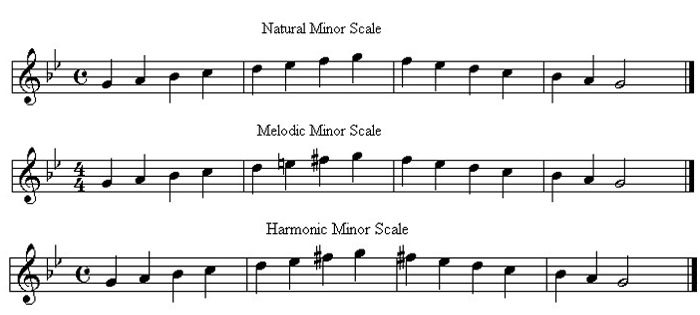natural minor scale

The scales of G natural minor, G melodic minor, and G harmonic minor.

The scale of G major.
The natural minor scale is one of the three commonest forms of minor scale, the others being the harmonic minor and the melodic minor. A natural minor scale can be derived from a major scale by using the sixth note of the major scale as the tonic of the minor scale. The natural minor scale has semitones (half steps) that fall between the second and third notes and the fifth and sixth notes.
| The minor scales shown using chromatic blocks | ||||||||||||
|---|---|---|---|---|---|---|---|---|---|---|---|---|
| chromatic scale | R | ♭2 | 2 | ♭3 | 3 | 4 | ♭5 | 5 | ♭6 | 6 | ♭7 | 7 |
| natural minor | R | 2 | ♭3 | 4 | 5 | ♭6 | ♭7 | |||||
| melodic minor (ascending) | R | 2 | ♭3 | 4 | 5 | 6 | 7 | |||||
| harmonic minor | R | 2 | ♭3 | 4 | 5 | ♭6 | 7 | |||||
Consider the scale of C major, the notes of which are just the white keys on a piano (no sharps or flats) beginning at C. The sixth note of this scale is A, which becomes the tonic, or keynote, of A minor. So the scale of A minor is A, B, C, D, E, F, G, A. This follows the step-pattern of all natural minor scales: tone, semitone, tone, tone, semitone, tone, tone. The third note of A minor is the keynote of C major. A minor is said to be the relative minor of C major. By the same token, C major is known as the relative major of A minor.
The relationship between the relative scales, then, is straightforward. The relative minor is three semitones down from the relative major; the relative major is three semitones up from the relative minor.
Note that the relative minor of C major is A minor not C minor. The notes of the C natural minor scale are C, D, E♭, F, G, A♭, B♭, C. These are the same notes as in the scale of E♭ major. So the scale of C natural minor is the relative minor of E♭ major. Any major scale can be converted to its corresponding natural minor by flatting the 3rd, 6th, and 7th notes. To give another example, the notes of G major, shown below, are G, A, B, C, D, E, F♯, G. Flatting the 3rd, 6th, and 7th notes yields the scale of G natural minor: G, A, B♭, C, D, E♭, F, G. This is the relative minor of B♭ major (because it starts on the sixth note of the G major scale and contains the same notes, but with a different step-pattern).
The important thing to be clear about is that every natural minor scale is also a relative minor scale but its relative major doesn't have the same name (because the relative major starts three semitones higher on a different keynote).
The major scale and its relative minor share the same key signature. However, because they start at different places, they have a different step-pattern and a different sound and feel. In simplistic terms, a major scale sounds "happy" and a natural minor "sad."
The primary chords of the natural minor scale are Im – IVm – Vm (or the subtonic – ♭VII chord).
The natural minor is the Aeolian mode of the relative major scale.


